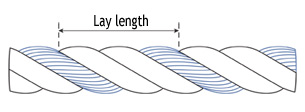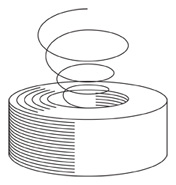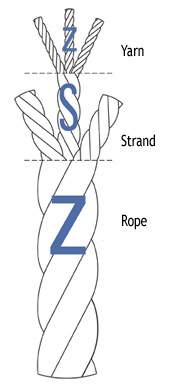Koordenfabriek Van Houte Exsil

Cable-Laid (Twisted)
The twist direction is indicated by the capital letters “S” and “Z”. When the rope is held vertically, the twist spires in the consecutive rope parts are in the same diagonal direction as indicated with the letter “S” (left hand) or
“Z” (right hand). The most common final twist for cabled ropes is “Z”.
The opposite twists result in a “balanced” rope. Varying the number of twists results in a more soft- or hard-laid rope - according to the customer's
preference. Without extra specifications, the rope is always produced as “medium” lay. The lay-length is then between 2,8 and 3,5 times the diameter.

Composition of a right hand twisted rope:
Single yarn: bundle of filaments twisted “Z” (right)
- Cabled yarn: composed of “S”-twisted yarns subsequently twisted together in the “Z” (right) direction
- Strand: assembly of yarns twisted “S” (left)
- Rope: assembly of strands “Z”-twisted together - for specific use cabled rope also exists in “S” lay
To avoid kinking it is recommended to uncoil “Z” twisted rope
by pulling out the inner end of the coil counterclockwise.

|

|

3-strand
Most common construction especially in northern Europe. Standard diameter 1-40mm.

4-strand with or without central core
The core can be a rope or a strand. Often used in southern Europe. Standard diameter 6-52mm.

6-strand + central core
Only used for speciality ropes such as compound steel wire/textile ropes, mooring ropes as
Superwinchline or
combination rope.
Standard diameter 12-96mm according to products.
Exsil n.v. - Koordenfabriek Van Houte n.v.
Industriezone Hoogveld
Schaapveld 14
9200 Dendermonde
Belgium
T +32 (0)52 26 01 50
F +32 (0)52 37 18 98
E
info@exsil.be
webdesign by Feel Good Inc







